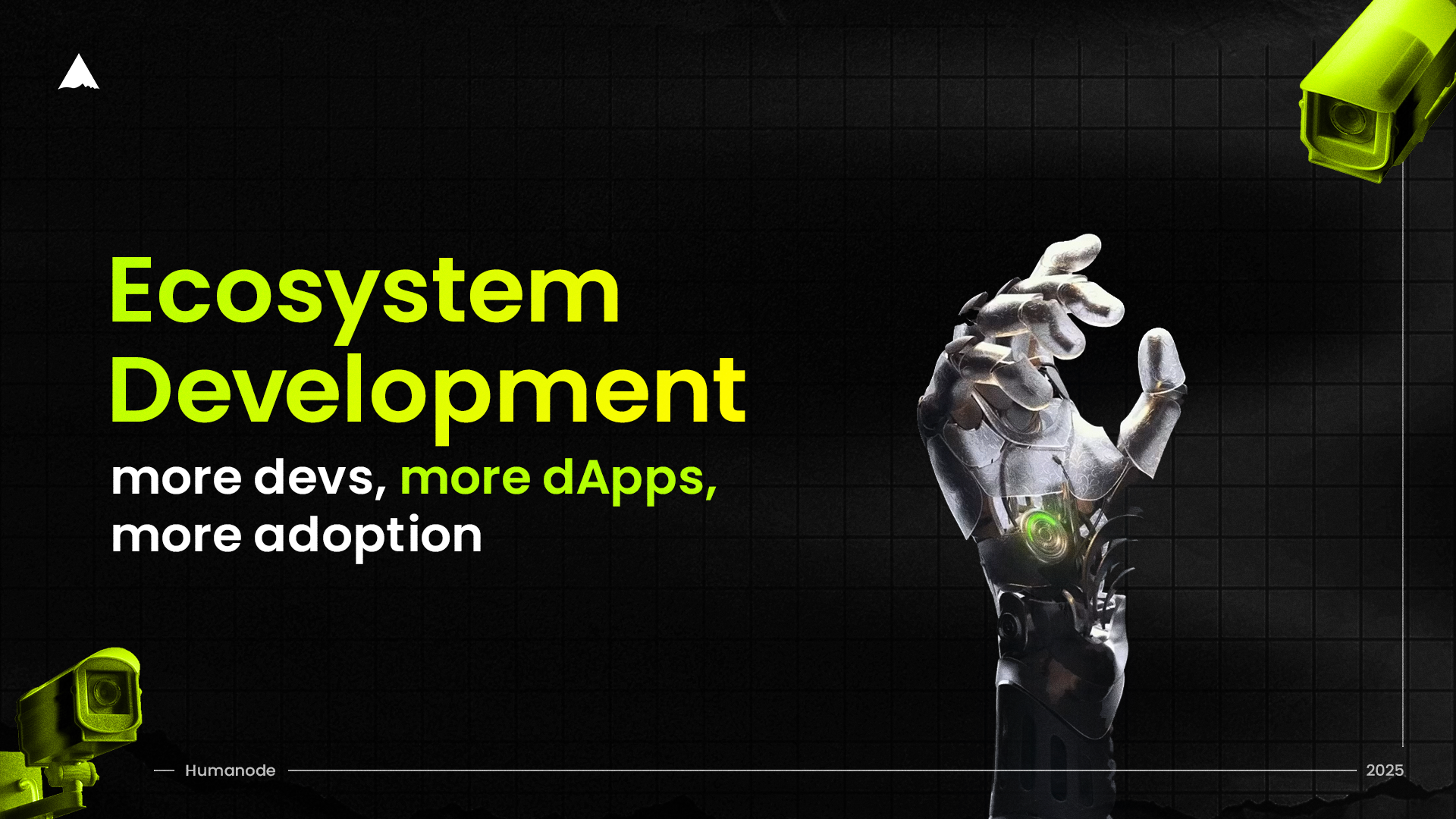Humanode’s Ecosystem Expansion: The Final Pillar of 1.0

If you’ve been following the journey toward Humanode 1.0, you’ve probably seen us talk about the four pillars that hold everything up. We’ve already covered three: Sybil resistance through cryptobiometrics (SRGate), governance through Vortex, and the push for true decentralization with 10,000 human nodes.
Now it’s time to discuss the fourth and final piece: Developer and Ecosystem Expansion.
If Humanode is to fulfill its vision of one human = one node = one vote, it must become more than a secure network, it must become an ecosystem. Because here’s the thing – having a decentralized global identity is powerful. Having Vortex as a fair governance model is essential. And yes, SRGate will give users control over how they use their biometric verification across apps. But without an ecosystem – without actual applications and projects running on Humanode, we’re just a beautifully built machine waiting to be turned on.
That is why to achieve our goals, the expansion of the Humanode ecosystem is a necessity. A place where builders can create without the baggage of whales, staking giants, or token-weighted governance.
And let’s make it clear, this isn’t just about attracting projects. It’s about bringing the human back into the equation – ensuring that every validator, every developer, and every user plays a role in shaping the network’s future.
So how do we get there? What’s already live? What’s coming next?
Let’s dive in.
Why ecosystem growth matters
So, why are we putting much emphasis on ecosystem expansion?
Because at the end of the day, a blockchain is only as strong as what gets built on it.
You can have the most secure, fair, Sybil-resistant system in the world, but if no one’s using it, if there are no apps, no users, no real-world value - then what’s the point?
That’s why growing the ecosystem is non-negotiable. Every new dApp, every integration, and every tool built on Humanode brings activity to the network. That activity means more users and more validator rewards. It creates a flywheel: more dApps lead to more usage, which leads to more demand for validators, which leads to stronger network effects.
And let’s not forget, projects built on Humanode come with Sybil-resistance built in. That’s a huge value-add for developers building systems that need fairness and trust from day one.
So this isn’t just growth for the sake of growth. This growth is essential for reinforcing the very core of Humanode: real humans securing real value, together.
The goal: A minimum of 10 deployed projects on Humanode
With all that said, what exactly are we aiming for?
Well, as part of Humanode 1.0, we’ve set a clear and simple goal: get at least 10 real projects deployed and running on the Humanode network.
Not just experiments. Not just one-off demos. We’re talking about full-on dApps, DeFi, gaming, social platforms, privacy-preserving tools, and actually using Humanode tech in the wild.
And guess what, we’re already making progress:
- Biomapper – Already live, and expanding with cross-chain functionality.
- Biostaker – Live and enabling Sybil-resistant LP staking.
- Catacomb Crawlers – Coming soon. A survivor-style Web3 game from Emeroth Studio.
- Project to be announced soon – Still under wraps, but in the pipeline working on the finishing touches.
That’s four down. The rest are on the way.
And while 10 is the goal for Humanode 1.0, the real vision is about utility. And as more projects go live, the value loop kicks in: more activity, more validator engagement, more real-world use cases. That’s how we grow a healthy, human-powered blockchain ecosystem.
And if you’re wondering how all this helps human nodes, don’t worry, we’re getting there.
What’s in it for human nodes
Alright, let’s talk brass tacks. All this talk about growth, new projects, and ecosystem expansion is exciting. But what does it mean for the people running validator nodes?
Let’s start with the obvious: more projects = more activity on-chain. Every time a user bioauthenticates, makes a transaction, interacts with a smart contract, or uses something like Biomapper or Biostaker – that’s a transaction. And every transaction comes with a fee. And on Humanode, those fees are distributed equally amongst human nodes.
So yes, more dApps = more earnings. But that’s just the start.
Apart from just getting fees from transactions to the fee pot, every new project that gets built on the Humanode network brings something more. For example, Emeroth Studio (behind Catacomb Crawlers) has pledged 1.5% of revenue from everything they build into this pot. That’s revenue flowing directly into validator rewards. As more projects follow this model, the pot grows.
And think about this, when more apps launch, they bring their own users, communities, and devs. Some of them will want to run validators themselves, increasing the demand for human nodes.
That means more people verifying, more people bioauthenticating, and more need for a decentralized base of real, active human validators.
And that’s the beauty of it: the system doesn’t just scale technically, it scales economically. Not by printing more tokens, but by actually growing the value being created on the network.
So, if you’re already a human, this ecosystem growth is your growth. And if you’re thinking about becoming one… well, now’s probably a good time to get in.
Supporting builders: The Ecosystem Funding Program
Now, you might be wondering, how exactly are these new projects coming to Humanode? Where are they coming from? Are we just hoping builders stumble into the ecosystem?
Not quite.
To kickstart the kind of ecosystem Humanode envisions—one built by and for real humans—we launched the Humanode Ecosystem Funding Program. It’s a major initiative aimed at bringing serious builders into the fold and giving them the support they need to launch, grow, and scale on Humanode.
Let’s talk numbers first:The program started with a $10 million funding pool, backed by the Humanode Foundation and supported by well-known names like Republic Crypto, Big Brain Holdings, and other strategic investors and angels. The goal? To empower Web3 projects that want to bring real use cases into a Sybil-resistant, human-first environment.
But this isn’t just about handing out checks. It’s a hands-on partnership that offers:
- Capital: Grants and milestone-based funding backed by Humanode Foundation, Republic Crypto, Big Brain Holdings, and others.
- Technical support: Tech help in building MVP, launching on Humanode, and scaling.
- Growth and community support: Go-to-market help with proposals and visibility on our Incubation site.
- Mentorship: Access to top-tier builders, strategists, and ecosystem experts.
And we’re not only focused on launching one type of dApp. Whether you're building in DeFi, GameFi, identity, governance, or something entirely new - if your project aligns with Humanode’s vision of Sybil-resistance and equality, you're welcome here.
One of the first projects in the program is Catacomb Crawlers, a Web3 game by Emeroth Studio (built by veterans who’ve worked on League of Legends, Final Fantasy, and Valorant). Not only will it be one of the first major games to launch on Humanode, but Emeroth Studio will be building more projects on Humanode.
Humanode Biomapper and Biostaker are already live. Catacomb is almost here. Another project is in the pipeline, and several more are in early-stage discussions. Our target? At least 10 solid projects live on Humanode by the time Humanode 1.0 goes public.
So, if you’re a builder, and you’re looking for a chain that’s aligned with your values, not just your bottom line, maybe it’s time to build where one human = one node = one vote.
You can learn more or apply for support here:Humanode Incubation ProgramOr check out the official announcement:Humanode Launches Ecosystem Funding Program
Because the Humanode ecosystem won’t grow by itself.It’ll grow because real people built it. Together.
Biomapper’s cross-chain push: A bonus boost
Now, while we’re on the topic of expanding the Humanode ecosystem – it’s worth taking a moment to talk about Biomapper going cross-chain.
Biomapper, for those just tuning in, is our biometric Sybil-resistance SDK. It lets dApps verify that a user is a real, unique human being, without needing their identity or sensitive data. It’s already live on chains other than Humanode.
With cross-chain deployment, Biomapper is available to dApps across EVM-compatible chains – Avalanche, Sei, Base, Filecoin, and Sonic.Now, here’s the cool part: Every time a user maps themselves through Biomapper, they bio-authenticate as a real human, and that human gets linked to the Humanode validator set.
So, even if a project is built on another chain, Humanode still grows.
More biomapped users = more validator demandMore integrations = more biometric authenticationsMore adoption = more revenue flowing into the validator ecosystem
In other words, Biomapper might be spreading out but its roots still grow deeper into Humanode.
And that’s the beauty of it.
We’re not here to build walled gardens. We’re here to plug biometric Sybil resistance into the rest of the Web3 world, and in doing so, pull more builders, users, and use cases into the orbit of a chain run by real humans – not by capital.
A call to developers
If you’re building something, consider this:
Humanode isn’t another blockchain. It’s a network powered by real people, with fairness, privacy, and Sybil-resistance built in.
Why build here?
- Live and tested: Humanode is already running with over 1,800 active, bio-authenticated validators. With 100% uptime.
- EVM-compatible: Use familiar tools, deploy Solidity smart contracts, and integrate with MetaMask and standard Web3 libraries.
- Scalable validator base: A human-powered validator set that grows with the ecosystem.
- Consensus agnostic chain: Human nodes can build a consensus to change the consensus algorithm.
- Native Sybil resistance: Built-in biometric verification for governance, airdrops, access, and more.
With Humanode 1.0, we’re actively onboarding devs ready to change the game.
You’re not just deploying a dApp – you’re helping shape a decentralized movement.
Looking ahead: The road beyond Humanode 1.0
Humanode 1.0 is not the end – it’s the launchpad.
We want to see:
- 50–100 devs actively building
- A constant stream of visionary projects
- A growing library of open-source tools, SDKs, and APIs
- More global events and funding opportunities
And as new dApps go live, they feed the network with activity, fees, and validator incentives.
If you’re a builder, validator, or community member – we invite you to build with us.
Join us. Help grow the first human-powered blockchain.

